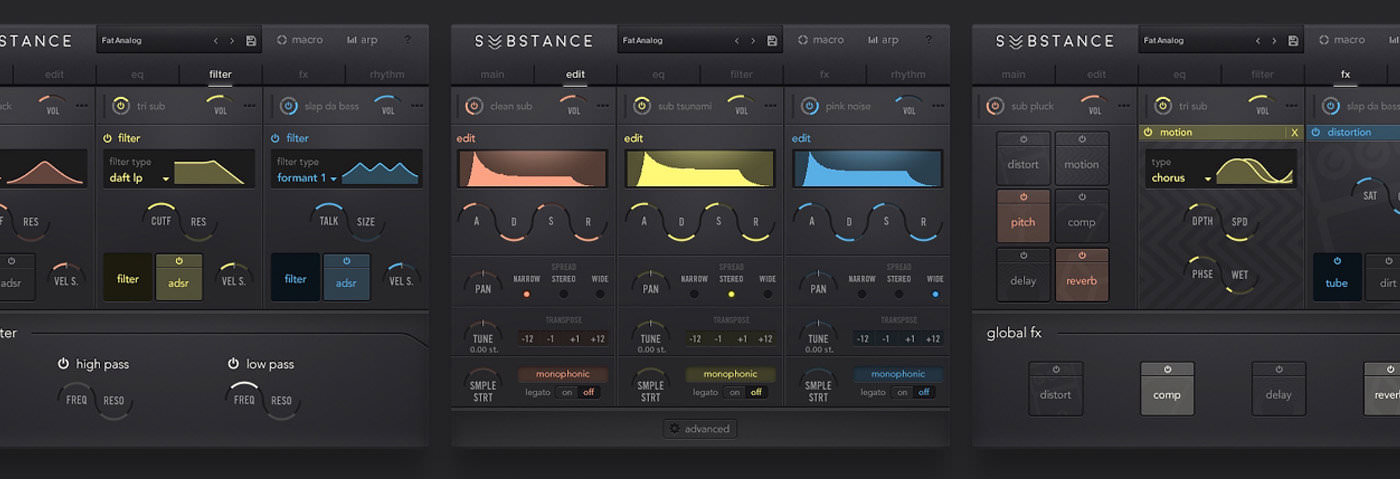Output follow up their popular Exhale, Movement and Rev releases with “hybrid bass instrument” Substance.
With products such as Movement and Rev, the Hollywood-based Output team has quickly developed a reputation for combining sleek GUIs with high quality sound. The company’s latest release, Substance, looks to follow in their footsteps by focusing its attention exclusively on bass sounds.
Before continuing, it’s worth noting how the company has updated its installer process. All of their instruments are designed to be hosted in NI Kontakt (including the free Kontakt Player). However, Output have recently rolled out their Output Hub, which can be used to install and update products, activate licences and add expansions. Once Output Hub is downloaded, installation is simple and you can add the instrument into Kontakt in the usual manner.
At its core, Substance is built around a three-layered architecture. Each layer uses a sound drawn from a series of categories: simple synths, bass guitars, low brass and woodwinds, processed bass guitars, organic hybrids, subs, synth plucks, complex synths, one shots and impacts. Via a series of views – Main, Edit, EQ, Filter, FX and Rhythm – you can individually manage the settings of each layer. To begin with, under Main you’ll see volume sliders for quick sub-mixing of the three layers and four additional sliders – Dirt, Filter, Attack and Shape – that control their combined output. Immediately after Main is the Edit pane. The three layers are displayed side by side with options to change the sound, envelope settings, panning, tune and sample start settings per layer.
The EQ view contains four separate three-band equalisers – one for each layer plus global EQ – but its capabilities are augmented substantially by the next pane, which offers four filters combined in a similar fashion. The three filters for the layers are as versatile as you could wish for, with a choice of ten modes and dedicated envelopes for each. They’re supplemented by global high- and low-pass filters (both with resonance controls). The effects on offer follow a similar format, with options including distortion, compression, delay and reverb available for each layer and/or global application.
Substance is good at various things but the standout quality is its ability to generate industrial, grainy and metallic sounds (in keeping with the slick but austere qualities of the GUI). However, it would be wrong to pigeonhole Substance as only being capable of these darker sounds; the sound engine is versatile enough to create a broader range of timbres. One of the most surprising aspects is the usefulness of the wide-ranging orchestral sounds. At first it might seem unconventional to mix, say, tuba samples with synth sub bass and modulated trombones, but the results of this kind of cross-genre layering can be surprisingly effective. Substance encourages you to think outside the box and combine elements you might not typically use. Whatever style of music you make, you’d be hard pushed not to find something useful here.
Beyond the basic sound design features, Substance is strong when it comes to performance options. The Rhythm tab straddles the two, allowing you to create rhythmic modulation sequences. Once again, these can be applied independently for each layer as well as globally. The options effectively combine LFO modulation with step sequencing. In conjunction with the arpeggiator and four programmable macros, it’s possible to create a huge variety of settings for performance, automation and complex modulation.
This level of multi-layered sound quality does, of course, come at a price in the form of high processing demands, but not to the extent that Substance is significantly worse than, say, a complex Massive patch. The only other major weakness is the DAW integration via Kontakt, which is less convenient than a self-contained plugin. However, Output appear to aware of the format’s limitations, and Substance does not rely on Kontakt’s library finder to access its own presets, which is a nice touch. The overall workflow of Substance is intuitive and generally very easy to understand.
Substance is an instrument that delivers on a number of levels and justifies its name in terms of the scope of its sound generation abilities. It offers a substantial amount of character without the need for an overcomplicated workflow, delivering superb versatility thanks to its multi-layered approach. At $199, it’s priced in the midrange as far as instruments go – a fair price point for a very well thought-out package, but probably not an impulse buy. However, it’s an impressively deep instrument that delivers more sound design options than you may expect at first glance. And besides all that, any instrument with a preset named ‘Donald Thump’ undoubtedly deserves a closer look.
The Verdict
Price: $199.99
Purchase: Output Substance
The Final Word
With a preset named 'Donald Thump', it undoubtedly deserves a closer look...
